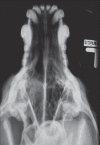A retrospective study of canine persistent nasal disease: 80 cases (1998-2003)
- PMID: 18320982
- PMCID: PMC2147700
A retrospective study of canine persistent nasal disease: 80 cases (1998-2003)
Abstract
Persistent canine nasal disease is a common complaint in small animal practice; however, an etiologic diagnosis can be difficult to establish. The aim of this retrospective study was to determine the percentage of cases for which the etiology was determined in our hospital population. Medical records from 80 dogs met the criteria of inclusion in the study. Nonspecific rhinitis was identified in 23.7% of cases. Other diagnoses were neoplasia (15.0%), fungal infection (nasal aspergillosis) (8.7%), cleft palate (8.7%), periodontal disease (4.0%), parasites (1.3%), foreign body (1.3%), and primary bacterial disease (1.3%). A definitive diagnosis could not be established in 36.3% of cases. Dogs with neoplastic and mycotic diseases often presented with severe radiographic and rhinoscopic lesions. Despite a systematic approach, numerous cases went undiagnosed. The use of advanced imaging should increase our ability to obtain an etiologic diagnosis in canine nasal disease.
Affections nasales persistantes chez le chien : Étude rétrospective de 80 cas (1998–2003). Les affections nasales persistantes chez le chien sont un motif de consultation fréquent en pratique des animaux de compagnie. Néanmoins, établir un diagnostic étiologique est parfois difficile. Le but de cette étude rétrospective est de déterminer le pourcentage de cas pour lesquels l’étiologie a été déterminée dans la population de chiens présentés à notre hôpital académique vétérinaire. Les données médicales de 80 animaux répondant aux critères d’inclusion de l’étude ont été analysées.
Dans 23,7 % des cas, une rhinite non spécifique a été identifiée. Les autres diagnostics ont été une tumeur nasale (15,0 %), une affection nasale fungique (8,7 %), une fente palatine (8,7 %), une maladie parodontale (4,0 %), des parasites nasaux (1,3 %), des corps étrangers (1,3 %) et une maladie bactérienne primaire (1,3 %). Dans 36,3 % des cas, le diagnostic n’a pas pu être établi. Les chiens atteints de néoplasie et d’infection fungique présentaient souvent des lésions sévères aux examens radiographiques et rhinoscopiques. Malgré une approche rigoureuse, de nombreux cas sont restés sans diagnostic. L’utilisation de techniques d’imagerie moderne devrait accroître notre capacité à établir un diagnostic étiologique chez les chiens atteints d’affection nasale persistante.
(Traduit par les auteurs)
Figures




Similar articles
-
A retrospective study of chronic nasal disease in 75 dogs.J S Afr Vet Assoc. 2009 Dec;80(4):224-8. doi: 10.4102/jsava.v80i4.212. J S Afr Vet Assoc. 2009. PMID: 20458862
-
Aetiology and diagnosis of persistent nasal disease in the dog: a retrospective study of 42 cases.J Small Anim Pract. 1999 Oct;40(10):473-8. doi: 10.1111/j.1748-5827.1999.tb02998.x. J Small Anim Pract. 1999. PMID: 10587924
-
Characteristics of canine nasal discharge related to intranasal diseases: a retrospective study of 105 cases.J Small Anim Pract. 2014 Mar;55(3):145-52. doi: 10.1111/jsap.12175. Epub 2014 Jan 15. J Small Anim Pract. 2014. PMID: 24423057
-
Pathogenesis and treatment of canine rhinitis.Vet Clin North Am Small Anim Pract. 1994 Sep;24(5):789-806. doi: 10.1016/s0195-5616(94)50101-3. Vet Clin North Am Small Anim Pract. 1994. PMID: 7817486 Review.
-
Rhinoscopy.Vet Clin North Am Small Anim Pract. 1990 Sep;20(5):1265-90. doi: 10.1016/s0195-5616(90)50304-6. Vet Clin North Am Small Anim Pract. 1990. PMID: 2238370 Review.
Cited by
-
Aspergillus versicolor, a new causative agent of canine disseminated aspergillosis.J Clin Microbiol. 2012 Jan;50(1):187-91. doi: 10.1128/JCM.05388-11. Epub 2011 Oct 26. J Clin Microbiol. 2012. PMID: 22031699 Free PMC article.
-
Construction of diagnostic prediction model for canine nasal diseases using less invasive examinations without anesthesia.J Vet Med Sci. 2023 Oct 19;85(10):1083-1093. doi: 10.1292/jvms.23-0315. Epub 2023 Sep 4. J Vet Med Sci. 2023. PMID: 37661430 Free PMC article.
-
Diagnostic benefits of platelet-to-lymphocyte, neutrophil-to-lymphocyte, and albumin-to-globulin ratios in dogs with nasal cavity diseases.BMC Vet Res. 2024 Feb 3;20(1):44. doi: 10.1186/s12917-024-03876-5. BMC Vet Res. 2024. PMID: 38310231 Free PMC article.
-
Host-microbe interactions in the nasal cavity of dogs with chronic idiopathic rhinitis.Front Vet Sci. 2024 Aug 12;11:1385471. doi: 10.3389/fvets.2024.1385471. eCollection 2024. Front Vet Sci. 2024. PMID: 39188898 Free PMC article.
-
Reverse Sneezing in Dogs: Observational Study in 30 Cases.Vet Sci. 2022 Nov 29;9(12):665. doi: 10.3390/vetsci9120665. Vet Sci. 2022. PMID: 36548826 Free PMC article.
References
-
- Cooke K. Sneezing and nasal discharge. In: Ettinger SJ, Feldman EC, editors. Textbook of Veterinary Internal Medicine. 6. Vol. 1. Saint-Louis: Elsevier Saunders; 2005. pp. 207–210.
-
- Tasker S, Knottenbelt CM, Munro EA, Stonehewer J, Simpson JW, Mackin AJ. Etiology and diagnosis of persistent nasal disease in the dog: A retrospective study of 42 cases. J Small Anim Pract. 1999;40:473–478. - PubMed
-
- Doust R, Sullivan M. Nasal discharge, sneezing, and reverse sneezing. In: King LG, editor. Textbook of Respiratory Diseases in Dogs and Cats. 1. Saint-Louis: WB Saunders; 2004. pp. 17–29.
-
- Bedford PG. Diseases of the nose. In: Ettinger SJ, Feldman EC, editors. Textbook of Veterinary Internal Medicine. 5. Vol. 1. Philadelphia: WB Saunders; 1995. pp. 551–567.
-
- Lecoindre P, Bergeaud P. Diagnostic des affections naso-sinusales : intérêt de la rhinoscopie. Etude rétrospective de 324 cas. Prat Med Chirur Anim Comp. 2003;38:263–275.
MeSH terms
LinkOut - more resources
Full Text Sources
Medical
Miscellaneous
